Broadband Absorption in Mid-Infrared via Trapezoidal Gratings Made of Anisotropic Metamaterial
Abstract
1. Introduction
2. Materials and Methods
3. Results
3.1. Broadband Absorption Efficiency Based on Multilayer Structure
3.2. Principle of the Broadband Absorption Based on Multilayer Structure
3.3. Effects of the Structure Geometry
3.4. Broadband Metamaterial Absorber Based on Dual-Sized Trapezoidal Gratings
4. Discussion
Author Contributions
Funding
Institutional Review Board Statement
Informed Consent Statement
Data Availability Statement
Conflicts of Interest
Abbreviations
| MMs | Metamaterials |
| MAs | Metamaterial absorbers |
| MIR | Mid-infrared |
| SiC | Silicon carbide |
| EMT | Effective medium theory |
| FEM | Finite element method |
| FWHM | Full bandwidth at half-maximum |
| Ge | Germanium |
References
- Cui, T.J.; Smith, D.R.; Liu, R. Metamaterials, Theory, Design, and Applications, 1st ed.; Springer: New York, NY, USA, 2010; pp. 49–58. [Google Scholar]
- Zheludev, N.; Kivshar, Y. From metamaterials to metadevices. Nat. Mater. 2012, 11, 917–924. [Google Scholar] [CrossRef] [PubMed]
- Venturi, G.; Mancini, A.; Melchioni, N.; Chiodini, S.; Ambrosio, A. Visible-frequency hyperbolic plasmon polaritons in a natural van der Waals crystals. Nat. Commun. 2024, 15, 9727. [Google Scholar] [CrossRef]
- Shelby, R.A.; Smith, D.R.; Schultz, S. Experimental verification of a negative index of refraction. Science 2001, 292, 77–79. [Google Scholar] [CrossRef] [PubMed]
- Pendry, J.B. Negative refraction makes a perfect lens. Phys. Rev. Lett. 2000, 85, 3966–3969. [Google Scholar] [CrossRef]
- Ma, H.; Cui, T.J. Three-dimensional broadband ground-plane cloak made of metamaterials. Nat. Commun. 2010, 1, 21. [Google Scholar] [CrossRef]
- Landy, N.I.; Sajuyigbe, S.; Mock, J.J.; Smith, D.R.; Padilla, W.J. Perfect metamaterial absorber. Phys. Rev. Lett. 2008, 100, 207402. [Google Scholar] [PubMed]
- Ren, Z.; Yang, Z.; Mu, W.; Liu, T.; Liu, X.; Wang, Q. Ultra-broadband perfect absorbers based on biomimetic metamaterials with dual coupling gradient resonators. Adv. Mater. 2025, 37, 2416314. [Google Scholar] [CrossRef]
- Estevez, D.; Qin, F. High-performance carbonaceous absorbers: From heterogeneous absorbers to data-driven metamaterials. Carbon 2025, 233, 119850. [Google Scholar] [CrossRef]
- Qing, Y.M.; Liu, J.; Yang, Z.; Gou, Y.; Wu, L.; Wu, J. Dynamic modulation of dual-band nonreciprocal radiation in a graphene-Weyl semimetal plasmonic structure. Appl. Phys. Lett. 2025, 126, 162203. [Google Scholar] [CrossRef]
- Qing, Y.M.; Liu, J.; Yang, Z.; Wu, L.; Gou, Y.; Wu, J.; Li, B. Dynamic modulation of nonreciprocal absorption in a graphene–InAs hybrid structure under low magnetic field and small incident angles. Opt. Lett. 2025, 50, 1552–1555. [Google Scholar] [CrossRef]
- Xiong, H.; Deng, J.; Yang, Q.; Wang, B.; Wang, X.; Zhang, H. A metamaterial energy power detector based on electromagnetic energy harvesting technology. ACS Appl. Electron. Mater. 2024, 6, 1204–1210. [Google Scholar] [CrossRef]
- Qing, Y.M.; Wang, H.; Lei, D. Wide-angle ultrabroadband absorption in black phosphorus/dielectric multilayer anisotropic metamaterials. J. Opt. 2024, 26, 065101. [Google Scholar] [CrossRef]
- Yun, M.J.; Sim, Y.H.; Lee, D.Y.; Cha, S.I. Honeycomb-structured 3D concave photovoltaic modules supported by 3D mechanical metamaterials for enhance light recapture. Adv. Mater. Technol. 2023, 8, 2201360. [Google Scholar] [CrossRef]
- Qing, Y.M.; Ma, H.; Cui, T. Tailoring anisotropic perfect absorption in monolayer black phosphorus by critical coupling at terahertz frequencies. Opt. Express 2019, 26, 32442–32450. [Google Scholar] [CrossRef]
- Wang, Y.; Liu, Z.; Zhou, F.; Yi, Z.; Wang, J. Perfect absorption properties of a near-infrared super-surface perfect absorber based on a multilayer subwavelength array structure. Phys. Lett. A 2025, 540, 130395. [Google Scholar] [CrossRef]
- Song, M.; Feng, L.; Huo, P.; Liu, M.; Huang, C.; Yan, F.; Lu, Y.; Xu, T. Versatile full-colour nanopainting enabled by a pixelated plasmonic metasurface. Nat. Nanotechnol. 2023, 18, 71–78. [Google Scholar] [CrossRef] [PubMed]
- Xiao, S.; Liu, T.; Cheng, L.; Zhou, C.; Jiang, X.; Li, Z.; Xu, C. Tunable anisotropic absorption in hyperbolic metamaterials based on black phosphorous/dielectric multilayer structures. J. Light. Technol. 2020, 37, 3290–3297. [Google Scholar] [CrossRef]
- Wang, X.; Duan, J.; Chen, W.; Zhou, C.; Liu, T.; Xiao, S. Controlling light absorption of graphene at critical coupling through magnetic dipole quasi-bound states in the continuum resonance. Phys. Rev. B 2020, 102, 155432. [Google Scholar] [CrossRef]
- Argyropoulos, C.; Le, K.Q.; Mattiucci, N.; D’Aguanno, G.; Alù, A. Broadband absorbers and selective emitters based on plasmonic Brewster metasurfaces. Phys. Rev. B 2013, 87, 205112. [Google Scholar] [CrossRef]
- Zhou, J.; Kaplan, A.F.; Chen, L.; Guo, L.J. Experiment and Theory of the broadband absorption by a tapered hyperbolic metamaterial array. ACS Photonics 2014, 1, 618–624. [Google Scholar] [CrossRef]
- Bagmanci, M.; Wang, L.; Sabah, C.; Karaaslan, M.; Paul, L.C.; Rani, T.; Unal, E. Broadband multi-layered stepped cone shaped metamaterial absorber for energy harvesting and stealth applications. Eng. Rep. 2024, 6, e12903. [Google Scholar] [CrossRef]
- Peng, G.; Ke, P.; Tseng, L.; Yang, C.; Chen, H. The design of a multilayer and planar metamaterial with the multi-functions of a high-absorptivity and ultra-broadband absorber and a narrowband sensor. Photonics 2023, 10, 804. [Google Scholar] [CrossRef]
- Jiang, Z.H.; Yun, S.; Toor, F.; Werner, D.H.; Mayer, T.S. Conformal dual-band near perfectly absorbing mid-infrared metamaterial coating. ACS Nano 2011, 5, 4641–4647. [Google Scholar] [CrossRef]
- Abouelez, A.E.; Eldiwany, E.A.; Swillam, M.A. Silicon-based ultra-broadband mid-IR and LWIR near-perfect metamaterial absorber. Opt. Quant. Electron. 2024, 56, 1103. [Google Scholar] [CrossRef]
- Chen, B.; Yu, S.; Lu, W.; Hao, Z.; Yi, Z.; Cheng, S.; Ma, C.; Tang, C.; Wu, P.; Ahmad, S. Mid-infrared bimodal wide metamaterial absorber based on double-layer silicon nitride structure. Mater. Res. Bull. 2024, 174, 112751. [Google Scholar] [CrossRef]
- Xi, Z.; Cen, Z.; Wang, D.; Thomas, J.G.; Srijanto, B.R.; Kravchenko, I.I.; Zuo, J.; Liu, H.; Ji, J.; Zhu, Y.; et al. Room-temperature mid-infrared detection using metasurface-absorber-integrated photonic crystals oscillator. Laser Photonics Rev. 2025, e00498. [Google Scholar] [CrossRef]
- Wu, Y.; Cheng, J.; Wen, W.; Wang, Q.; Gao, X.; Zhu, Z. Study on effective dielectric properties of silicon carbide composites. Phys. B Condens. Matter 2020, 595, 412376. [Google Scholar] [CrossRef]
- Korobkin, D.; Urzhumov, Y.; Shvets, G. Enhanced near-field resolution in midinfrared using metamaterials. J. Opt. Soc. Am. B 2006, 23, 468. [Google Scholar] [CrossRef]
- Tan, Z.; Dong, L.; Lyu, Z. Silicon carbide aerogels: Fabrication, properties, and applications. Small 2025, 21, 2500907. [Google Scholar] [CrossRef]
- Qing, Y.M.; Yang, Z.; Wang, Y.; Ren, Y.; Wu, J. Polarization-dependent near-field coupling and far-field harmonic modulation in a graphene-based plasmonic nanostructure. Phys. Scr. 2024, 99, 105547. [Google Scholar] [CrossRef]
- Rufangura, P.; Cui, Y.; Liu, H.; Carlstrom, J.D.; Crozier, K.; Brongersma, M.L.; Yang, Y.; Iacopi, F. Near unity narrowband infrared thermal emitters on silicon with silicon carbide-germanium metasurfaces. APL Photonics 2025, 10, 080802. [Google Scholar] [CrossRef]
- Zhao, B.; Zhang, Z.M. Study of magnetic polaritons in deep gratings for thermal emission control. J. Quant. Spectrosc. Radiat. Transf. 2014, 135, 81–89. [Google Scholar] [CrossRef]
- Choy, T.C. Effective Medium Theory: Principles and Applications, 2nd ed.; Oxford University Press: Oxford, UK, 2015. [Google Scholar]
- Smith, D.R.; Schultz, S.; Markoš, P.; Soukoulis, C.M. Determination of effective permittivity and permeability of metamaterials from reflection and transmission coefficients. Phys. Rev. B 2002, 65, 195104. [Google Scholar] [CrossRef]
- Qing, Y.M.; Ma, H.F.; Ren, Y.Z.; Yu, S.; Cui, T.J. Near-infrared absorption-induced switching effect via guided mode resonances in a graphene-based metamaterial. Opt. Express 2019, 27, 5253. [Google Scholar] [CrossRef] [PubMed]
- Liu, X.; Starr, T.; Starr, F.; Padilla, W.J. Infrared spatial and frequency selective metamaterial with near-unity absorbance. Phys. Rev. Lett. 2010, 104, 207043. [Google Scholar] [CrossRef]
- Lee, B.J.; Wang, L.P.; Zhang, Z.M. Coherent thermal emission by excitation of magnetic polaritons between periodic strips and a metallic film. Opt. Express 2008, 16, 11328–11336. [Google Scholar] [CrossRef]
- Cui, Y.; Fung, K.H.; Xu, J.; Ma, H.; Jin, Y.; He, S.; Fang, N.X. Ultrabroadband light absorption by a sawtooth anisotropic metamaterial slab. Nano Lett. 2012, 12, 1443–1447. [Google Scholar] [CrossRef]

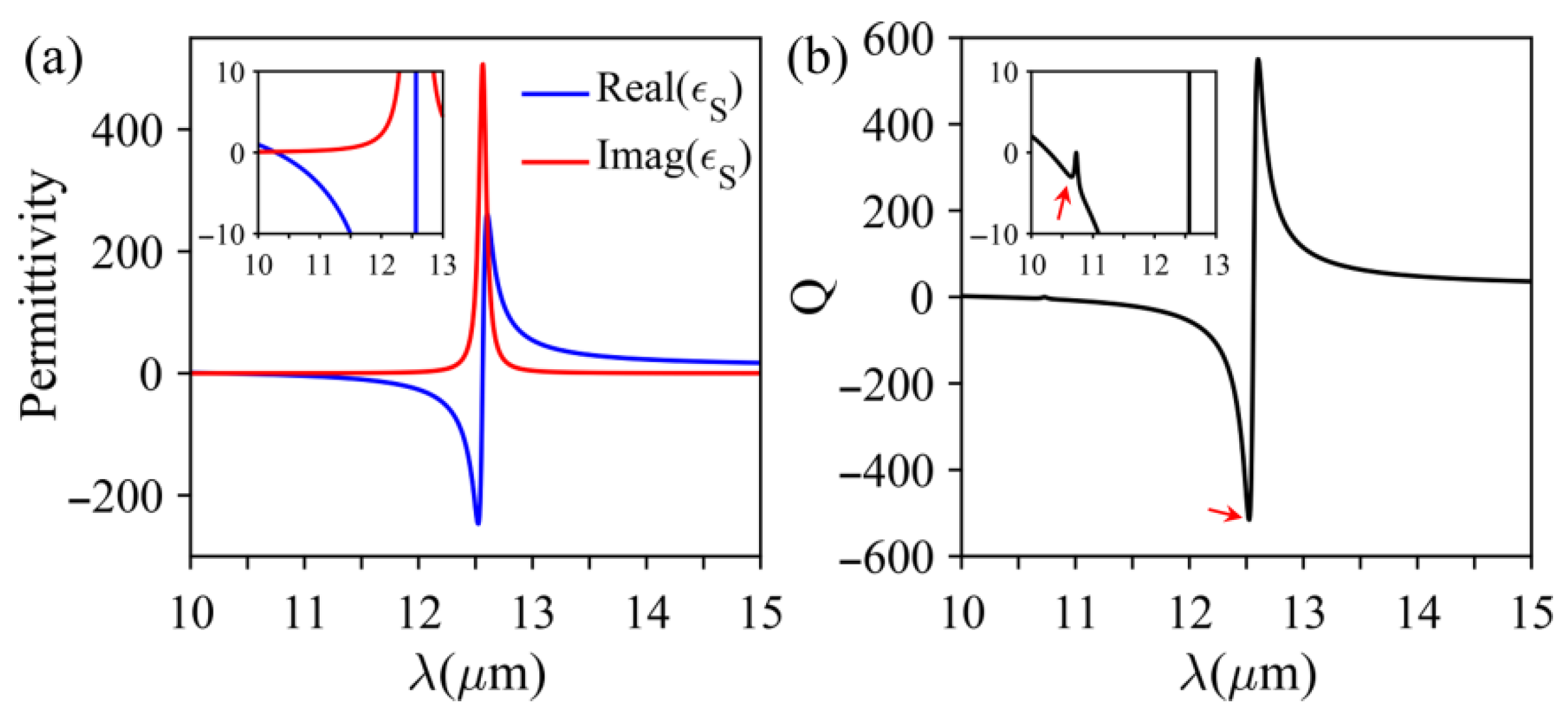



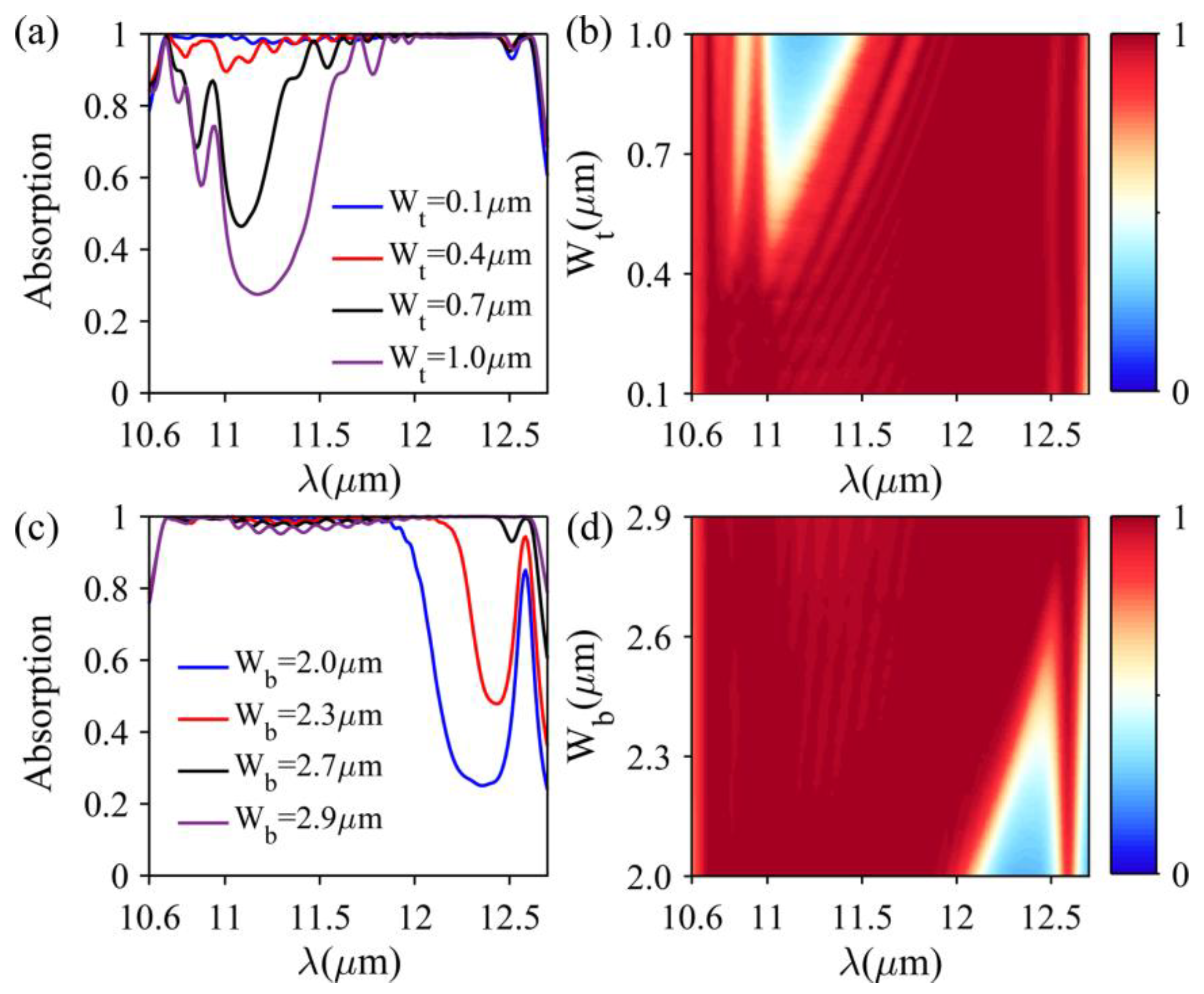
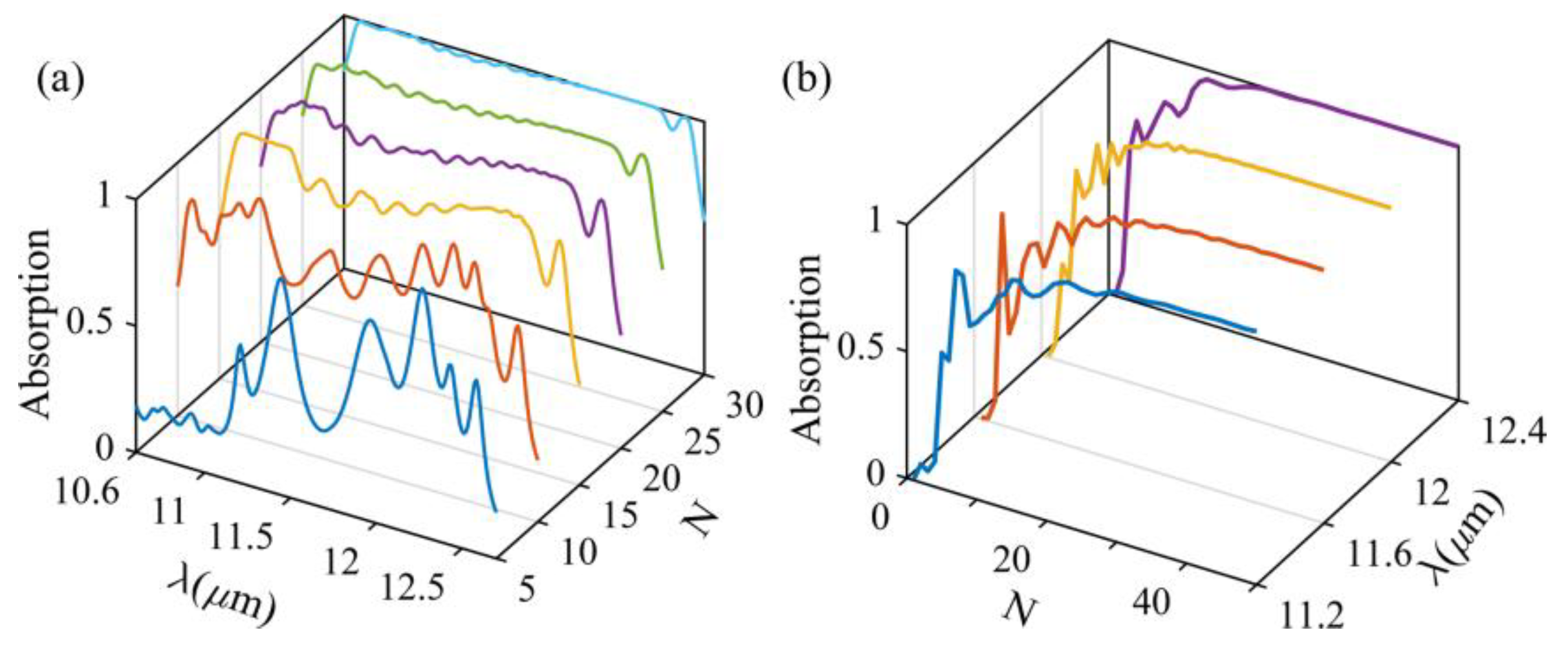
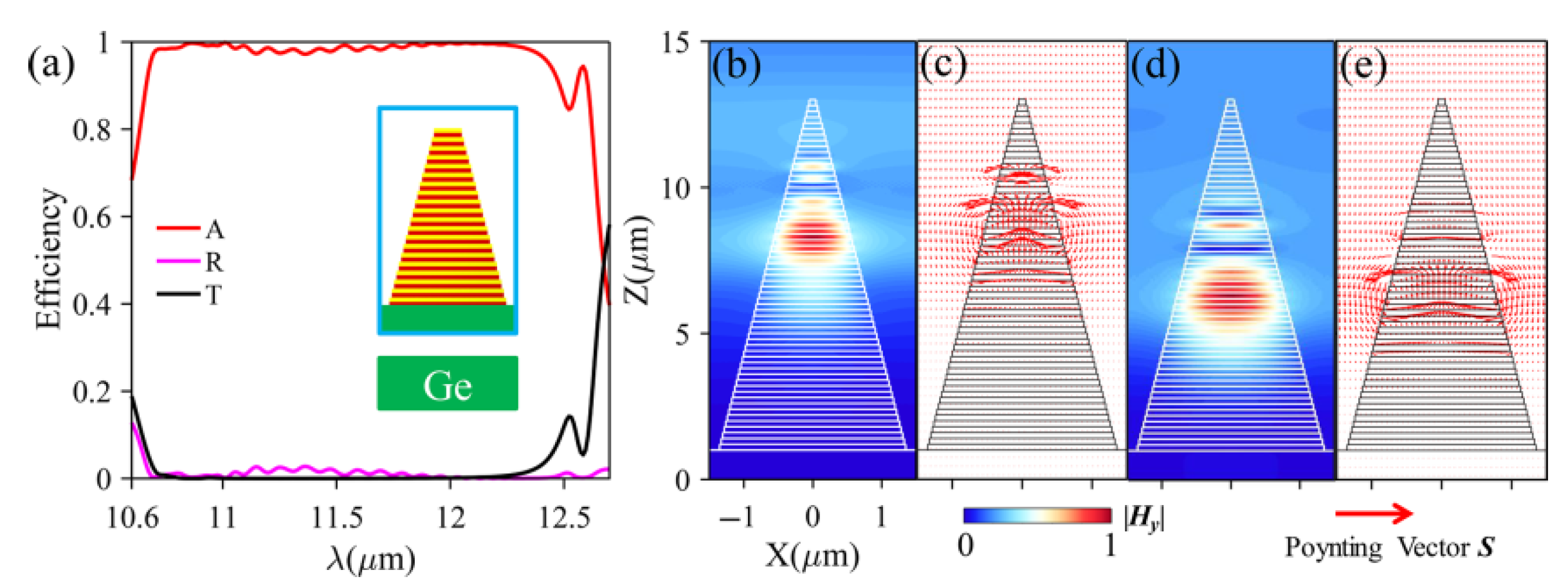
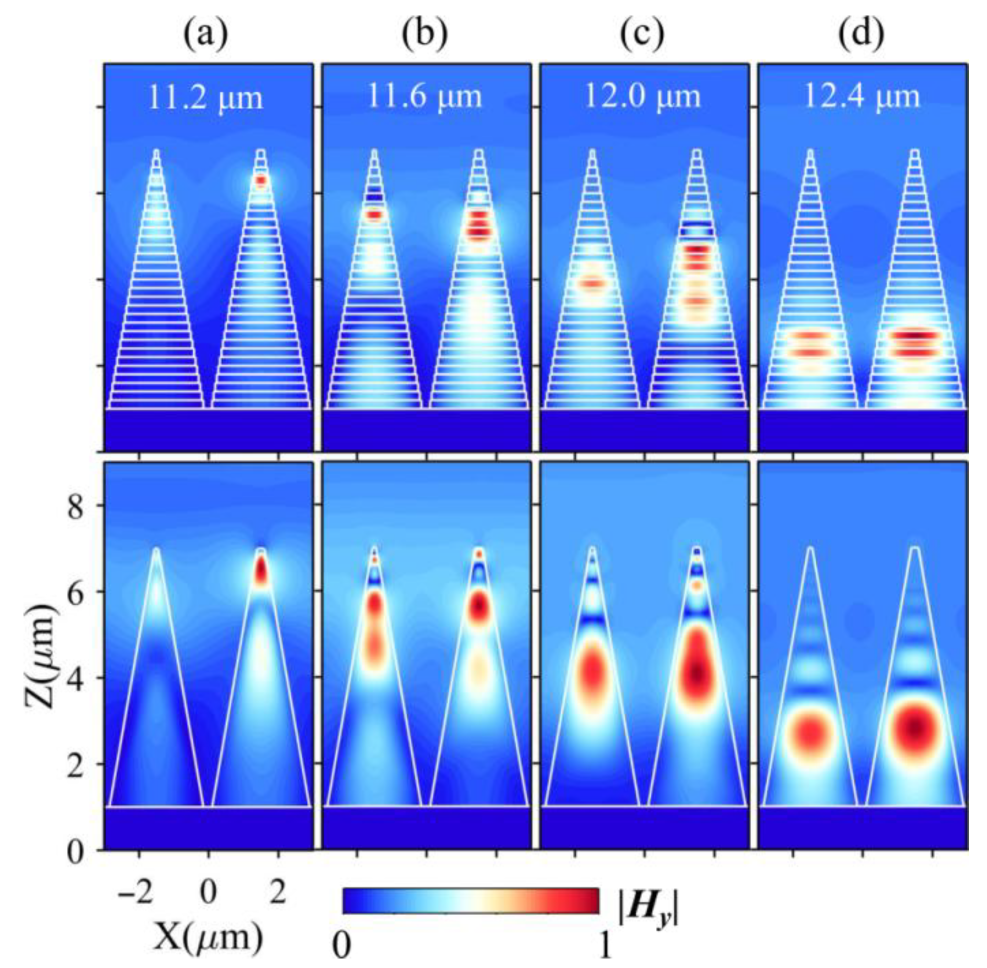

Disclaimer/Publisher’s Note: The statements, opinions and data contained in all publications are solely those of the individual author(s) and contributor(s) and not of MDPI and/or the editor(s). MDPI and/or the editor(s) disclaim responsibility for any injury to people or property resulting from any ideas, methods, instructions or products referred to in the content. |
© 2025 by the authors. Licensee MDPI, Basel, Switzerland. This article is an open access article distributed under the terms and conditions of the Creative Commons Attribution (CC BY) license (https://creativecommons.org/licenses/by/4.0/).
Share and Cite
Ren, Y.; Gao, J.; Jiang, Z.; Yang, Z.; Liu, J.; Gou, Y.; Qing, Y. Broadband Absorption in Mid-Infrared via Trapezoidal Gratings Made of Anisotropic Metamaterial. Photonics 2025, 12, 932. https://doi.org/10.3390/photonics12090932
Ren Y, Gao J, Jiang Z, Yang Z, Liu J, Gou Y, Qing Y. Broadband Absorption in Mid-Infrared via Trapezoidal Gratings Made of Anisotropic Metamaterial. Photonics. 2025; 12(9):932. https://doi.org/10.3390/photonics12090932
Chicago/Turabian StyleRen, Yongze, Jiale Gao, Zhuofan Jiang, Zhaoyan Yang, Jiao Liu, Yue Gou, and Yeming Qing. 2025. "Broadband Absorption in Mid-Infrared via Trapezoidal Gratings Made of Anisotropic Metamaterial" Photonics 12, no. 9: 932. https://doi.org/10.3390/photonics12090932
APA StyleRen, Y., Gao, J., Jiang, Z., Yang, Z., Liu, J., Gou, Y., & Qing, Y. (2025). Broadband Absorption in Mid-Infrared via Trapezoidal Gratings Made of Anisotropic Metamaterial. Photonics, 12(9), 932. https://doi.org/10.3390/photonics12090932





